Canon EF 70-300mm f/4.5-5.6 DO IS USM Review
-
Ease
of Use -
Sample
Images -
Lens
Specs -
Rating &
Conclusion -
Main
Rivals -
Review
Roundup - Comment
-
More…

Introduction
As one of two lenses fitted with diffractive optics, the Canon EF 70-300mm f/4.5-5.6 DO IS USM has a smaller barrel than the other 70-300mm lenses from Canon. Recognised by the green ring where an L lens would be red and a USM lens would be gold, the DO lens is less than 10cm in length. The DO elements fitted to these lenses incorporate the qualities of fluorite and UD lenses, so does this make them an upgrade from the L series? According to the Canon website, the lens is more expensive than the recently released 70-300mm L series but looking around other places, it sits around £80-100 less. As well as helping produce high contrast images, the main feature of the DO lens is that it helps reduce chromatic aberration, or colour fringing. The Canon EF 70-300mm f/4.5-5.6 DO IS USM currently retails for £1700 / $1,349.95.
Ease of Use
 The Canon EF 70-300mm f/4.5-5.6 DO IS USM lens attached to a Canon EOS 5D Mark II body
The Canon EF 70-300mm f/4.5-5.6 DO IS USM lens attached to a Canon EOS 5D Mark II body
As a top of the range lens, the 70-300mm DO has all the luxury features you'd expect such as Image Stabiliser with modes 1 and 2, ultrasonic lens and a zoom ring lock to avoid zoom creep. Build quality is excellent; the lens feels solid and robust. The zoom ring is smooth but firm although it can't prevent creeping - hence the lock at 70mm.
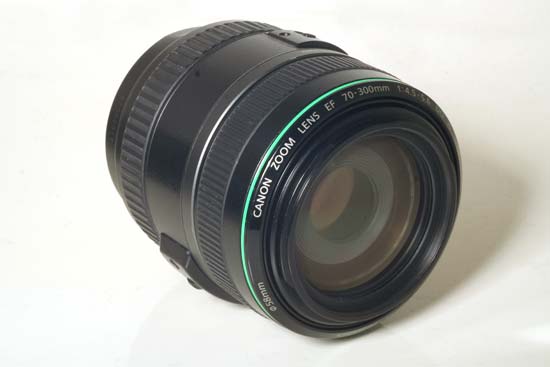 The front of the Canon EF 70-300mm f/4.5-5.6 DO IS USM lens
The front of the Canon EF 70-300mm f/4.5-5.6 DO IS USM lens
 The rear of the Canon EF 70-300mm f/4.5-5.6 DO IS USM lens
The rear of the Canon EF 70-300mm f/4.5-5.6 DO IS USM lens
Weighing in at 720g, the 70-300mm DO is around 90g heavier than the standard 70-300mm lens but is positively lightweight when compared to the new 70-300mm L lens which comes in at a roly poly 1050g.
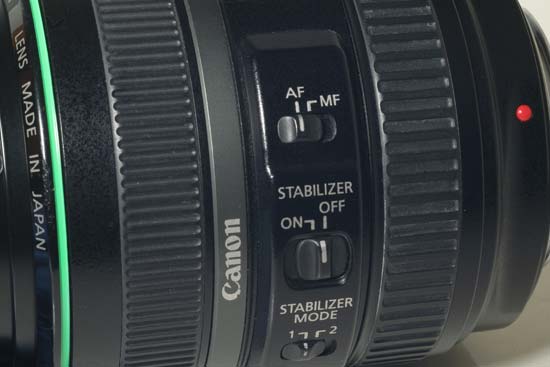 The stabiliser on/off switch
The stabiliser on/off switch
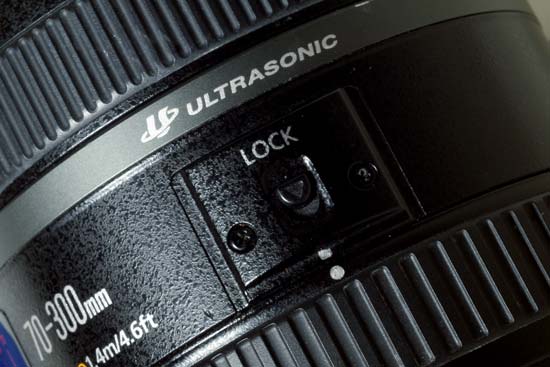 The locking switch
The locking switch
At 70mm, the lens is only 9.99cm which is around 5cm shorter than the L version. However, the zoom is external and at full 300mm zoom, it extends approximately an extra 6cm.
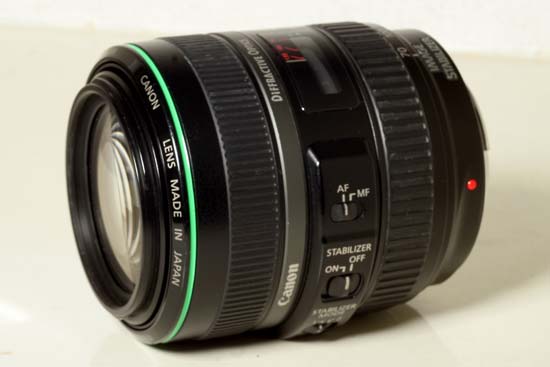 The Canon EF 70-300mm f/4.5-5.6 DO IS USM lens at 70mm
The Canon EF 70-300mm f/4.5-5.6 DO IS USM lens at 70mm
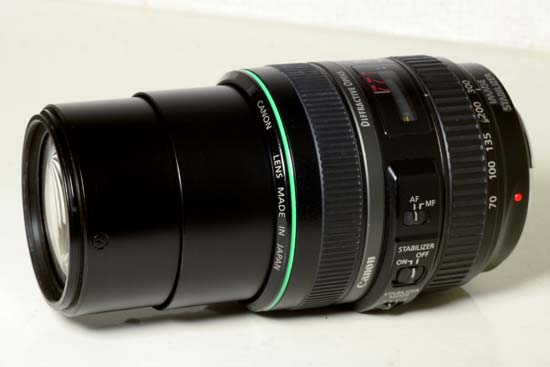 The Canon EF 70-300mm f/4.5-5.6 DO IS USM lens at 300mm
The Canon EF 70-300mm f/4.5-5.6 DO IS USM lens at 300mm
Focal Range
At 70mm, the lens has a 29° angle of view.
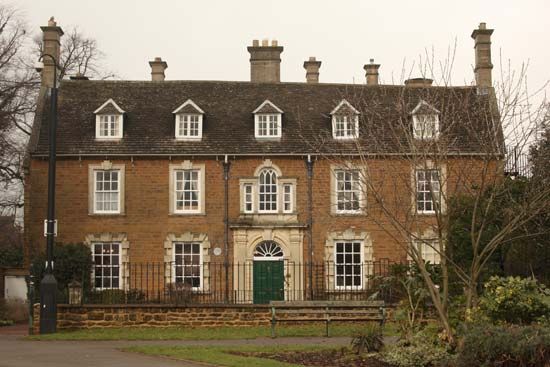 Field of view at 70mm
Field of view at 70mm
At 300mm, the lens has a 6° 50' angle of view according to the Canon website.
 Field of view at 300mm
Field of view at 300mm
Focusing
Focusing is completely internal and the only indication is on the distance scale window. The Ultrasonic Motor is the ring type which is the better quality of the two types of USM motor that Canon fit as it uses a simple design of two rings, one attached to the focusing bits and the other is attached to the lens barrel. When one vibrates, it translates to the other as movement and the lens focuses. It's noticeably faster than the standard focusing motor, virtually silent and also boasts the advantage of allowing manual override of autofocus which is great for fine tuning. The ring type USM is found on the top of the range lenses while the lower range models are fitted with the micro USM type which works on roughly the same principle but is slower and noisier due to using a gear train.
The focusing of some lenses can alter the composition of the frame by appearing to adjust the focal length slightly. This effect is called focus breathing and is more common in video but has been found in photographic lenses too. The Canon EF 70-300mm f/4.5-5.6 DO IS USM doesn't suffer from the problem at all.
Chromatic Aberrations
This is the area where the DO lens excels. Or it should do. The DO letters stand for diffractive optics and are specially designed to eliminate colour fringing. It's worth noting that the phenomenon can still appear because of the micro lenses on the sensor.
I tested the lens with as many high contrast images as I could and couldn't detect any traces of chromatic aberration on any of the pictures I took.
Macro
The Canon EF 70-300mm f/4.5-5.6 DO IS isn't a macro lens and the closest focusing distance is a measly 1.4m. That's measly only compared to a macro lens of course and quite similar to the other 70-300mm lenses from Canon.
Bokeh Examples
Bokeh derives from the Japanese ??which means "blur" and is used to describe how pleasing the out of focus area is in the picture. It was first coined in the mid-nineties by the Editor of Photo Techniques magazine.
Bokeh can be improved by using more aperture blades or rounded versions to create more of a circle which in turn creates better circles when photographing a night scene with lights in the background. Straight or fewer blades on a lens will produce a more polygonal shape but the great thing about bokeh is that it's subjective. What works for one person may not work for another.
The 70-300mm lens features 6 aperture blades which is less than the eight found on the L lens and the standard 70-300mm lens although the DO lens has rounded blades to create more of a circle.
 Bokeh
Bokeh
Sharpness
In order to show you how sharp this lens is, we are providing 100% crops on the following pages.
-
Ease
of Use -
Sample
Images -
Lens
Specs -
Rating &
Conclusion -
Main
Rivals -
Review
Roundup - Comment
